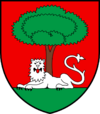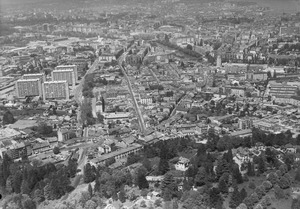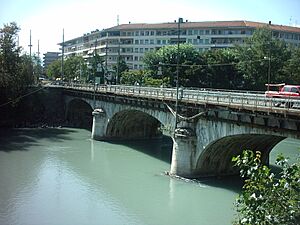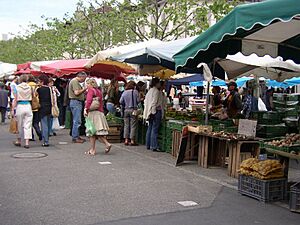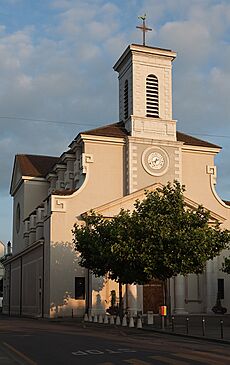Carouge facts for kids
Quick facts for kids
Carouge
|
||
|---|---|---|
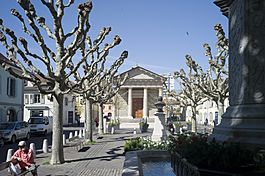 |
||
|
||
| Country | Switzerland | |
| Canton | Geneva | |
| District | n.a. | |
| Area | ||
| • Total | 2.7 km2 (1.0 sq mi) | |
| Elevation | 386 m (1,266 ft) | |
| Population
(Dec 2020 )
|
||
| • Total | 22,536 | |
| • Density | 8,350/km2 (21,600/sq mi) | |
| Postal code |
1227
|
|
| Surrounded by | Geneva (Genève), Lancy, Plan-les-Ouates, Troinex, Veyrier | |
Carouge is a lively city in the Canton of Geneva, Switzerland. It's known for its unique charm and history. Carouge is often called "Sardinian Carouge" because of its special architecture. It feels different from the nearby city of Geneva.
Contents
History of Carouge
Carouge has a long history. It was first mentioned way back in the Early Middle Ages. People called it Quadruvium or Quatruvio. Later, in 1248, it was known as Carrogium.
The city you see today was built starting in the 1760s. Victor Amadeus III of Sardinia, who was the King of Sardinia, helped create it. Carouge officially became a city in 1786.
In 1792, during the French Revolution, France took control of Carouge. Many local people supported this change. After the Napoleonic wars, in 1814, Carouge became part of the Kingdom of Sardinia again. But soon after, in 1816, it joined the Canton of Geneva. This meant Carouge became part of the Swiss Confederation.
Geography of Carouge
Carouge covers an area of about 2.7 square kilometers (about 1 square mile). A small part of this land, about 4.8%, is used for farming. About 8.5% of the area is covered by forests.
Most of Carouge, about 83.3%, is built up with buildings and roads. This includes homes, shops, and places for transport. A small part, about 1.5%, is made up of rivers. The city is located south of the Rhone and Arve rivers.
People of Carouge
| Nationality | Number | % of total population |
|---|---|---|
| 1,972 | 9.5 | |
| 1,156 | 5.6 | |
| 1,038 | 5.0 | |
| 618 | 3.0 | |
| 196 | 0.9 | |
| 182 | 0.9 | |
| 174 | 0.8 | |
| 167 | 0.8 | |
| 128 | 0.6 | |
| 112 | 0.5 | |
| 98 | 0.5 | |
| 86 | 0.4 | |
| 71 | 0.3 | |
| 69 | 0.3 | |
| 65 | 0.3 | |
| 62 | 0.3 | |
| 60 | 0.3 | |
| 57 | 0.3 | |
| 57 | 0.3 | |
| 52 | 0.2 |
Carouge has a population of over 20,000 people. Many people from other countries live here. In 2008, about 37.7% of the people living in Carouge were foreign nationals. The population has grown quite a bit over the years.
Most people in Carouge speak French. It is the most common language. Other languages spoken include Portuguese and Italian.
In 2000, about 21.4% of the population were children and teenagers (0–19 years old). Adults (20–64 years old) made up 65.1% of the population. Seniors (over 64 years old) made up 13.4%.
There are many households in Carouge. On average, there are about 2 people living in each home. Many homes are for single people.
How Carouge's population has grown
This chart shows how the number of people living in Carouge has changed over time. You can see how the population has grown and changed through the years.

Important Heritage Sites
Carouge has some very important historical places. The Archives of Carouge is a special place. It is listed as a Swiss heritage site of national significance. This means it is very important for the country's history. The entire old village of Carouge is also a protected site. It is part of the Inventory of Swiss Heritage Sites.
Carouge's Economy
Carouge is a busy place for jobs. In 2010, the unemployment rate was 9.3%. This means that about 9 out of every 100 people looking for work could not find a job.
Many people work in different types of jobs.
- The primary sector involves jobs like farming.
- The secondary sector includes jobs in factories and construction.
- The tertiary sector is the largest. It includes jobs in services. This means things like sales, transport, hotels, restaurants, and healthcare.
In 2008, there were over 18,000 full-time jobs in Carouge. Most of these jobs were in the service sector. This shows that Carouge is a center for many different businesses and services.
Many people travel into Carouge for work every day. About 2.8 workers come into Carouge for every one person who leaves to work elsewhere. This means Carouge is a major workplace for the region. Many people use public transport or private cars to get to work.
Religion in Carouge
In Carouge, many different religions are practiced. According to a 2000 survey:
- About 44.4% of people were Roman Catholic.
- About 13.5% belonged to the Swiss Reformed Church.
- Some people belonged to other Christian churches.
- There were also people who were Islamic or Jewish.
- About 24.48% of the people said they did not belong to any church. They were agnostic or atheist.
Fun Things to Do in Carouge
Carouge offers many fun activities and places to visit!
- Sports: If you like football, Étoile Carouge is the local football club. They play in the Promotion League. There are also swimming pools, like the outdoor Olympic pool called Piscine de la Fontenette. There is also an indoor pool, Piscine des Pervenches.
- Culture: You can visit the Musée de Carouge, which is the city's museum. For movie lovers, Bio 72 is a cinema that shows independent films. The Thétre de Carouge-Atelier de Genève is a popular theatre.
- Outdoors: The Arve River runs along the north-east side of Carouge. It has a great path for walking and cycling. You can even rent a bicycle for free at the Genève roule station at Place de l'Octroi.
Education in Carouge
Carouge has a good education system. Many people have completed higher education. In 2000, about 29.7% of the people had finished high school. About 18.4% had gone on to university or other higher education.
The school system in Geneva, where Carouge is located, works like this:
- Young children can attend two years of non-required Kindergarten.
- Students then go to six years of primary school. Some children attend smaller, special classes.
- After primary school, there are three required years of secondary school.
- Then, students can choose to go to three to five years of optional advanced schools.
In the 2009–2010 school year, there were over 3,800 students in Carouge's schools. This included children in kindergarten, primary school, and secondary school. Some students also attended private schools.
Famous People from Carouge
Carouge has been home to several notable people.
- Gaspard Mermillod (1824–1892) was an important leader in the Roman Catholic Church.
- James Vibert (1872–1942) was a famous sculptor. He was a pioneer of the Symbolism art movement in Switzerland.
- René Paresce (1886–1937) was a painter and writer from Switzerland and Italy.
- Marcel Bolomet (1905–2003) was a Swiss-French photographer. He was the first official photographer for the United Nations.
- Georges Cottier (1922–2016) was also a Cardinal of the Roman Catholic Church.
- Vincent Rüfli (born 1988) is a professional football player.
- Jenny Fähndrich (born 1989) is a professional BMX cyclist. She competed in the 2008 Summer Olympics.
See also
 In Spanish: Carouge para niños
In Spanish: Carouge para niños


